Raspberries are native to Asia, North America, and Europe. They have been enjoyed in Greece since ancient times. King Edward I was the first to call for the cultivation of these berries, resulting in British gardens being full of raspberry bushes by the 13th century. By the 18th century, production had expanded to the rest of Europe.
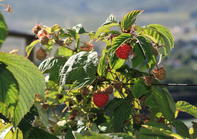
Raspberries were long considered a luxury food, as only the rich could afford these exotic berries. By the Middle Ages, it already had numerous uses as a health treatment, medication, as well as a colourant.
The multi-purpose raspberry may have derived its name from a sweet rose-coloured wine called raspeys. It is believed that the German word ‘raspoie’ which means thicket, or the English word ‘rasp’ - in reference to the rough surface of the berry, may have inspired the berry’s name as we know it today.
International Production
International production has almost doubled since 2007, because of consumers becoming more health-conscious and raspberries being seen as a superfood. The biggest producers, as reported by the International Raspberry Organisation are Poland, Serbia, Chile and China.
Poland had 26 000 ha under production in 2016, yielding 120 000 tons of berries at 4.5 tons per hectare, whereas Serbia had 15 000 ha under production that yielded 110 000 tons of berries at 5.6 tons/ha. In 2019, China had 15 000 ha that produced 75 000 tons of berries at 5 tons/ha. Chile had 9 000 ha under production, producing 36 000 tons of berries at 4 tons/ha.
The United States, which is also a major player, had 4 200 ha under production in 2018, which yielded 48 000 tons of berries at roughly 11 tons/ha. Most of these berries are produced in California.
Local Production
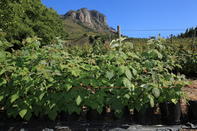
While production is growing in South Africa, the industry is still small with only a handful of producers accounting for more than 8% of production, if not more. There are various reasons for this.
One reason is that plant material is limited and difficult to come by. Production is labour intensive and requires expensive cooling infrastructure for post-harvest management. The fruit also damages easily and has a short shelf-life.
Production
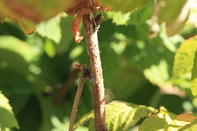
Production primarily occurs in the Western Cape and the Free State. Raspberries are generally produced in deep, well-drained loam or sandy loam soils with high organic matter.
The high returns have motivated producers in some countries to grow the berries under protection, such as shade nets or tunnels. Whether this will be a viable option in South Africa, will largely depend on the cost of the infrastructure and energy costs for climate control.
Production Season
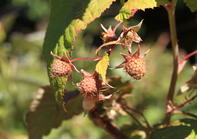
Summer bearers have a high chill requirement similar to apples and produce a single crop during the summer season. They are able to thrive in most of the areas where apples are planted.
Autumn bearers have a low chill requirement, yielding a crop early in the summer and again in the late summer to fall. They are suited to warmer subtropical areas.
Varieties
A range of varieties are planted, primarily depending on the suitability of a specific variety for production in a specific area and the market demand for that variety. The main spring bearers are Glen Prosen, Glen Lyon and Tulameen, whereas the main autumn bearers are Heritage and Autumn bliss.
Depending on the variety, raspberries come in red, black, yellow and purple, with the red and yellow coloured raspberries belonging to the same species and being the hardiest of the lot. Blackberries belong to a different subspecies. They are generally less cold tolerant and seedier than the red varieties. The purple varieties are highly vigorous plants developed out of a cross of black and red raspberries.
Cooling and the level of maturity also have an impact on the colour. In 2019, the raspberries preferred by consumers are the dark red or pink almost orange-red berries.
Sales
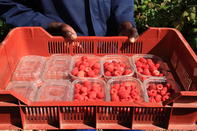
The international and local demand for raspberries has been growing steadily over the past few years. Most of South Africa’s raspberries are exported, with roughly 80% of these berries destined for the United Kingdom. The remaining 20% is sent to the Middle East and the European Union.
Uses
Raspberries have been labelled a superfood because they are full of antioxidants, rich in fibre and contain high levels of vitamin A and C. They are also cholesterol-free and contain phytonutrients, which are said to ward off obesity by increasing enzyme activity and oxygen consumption.
Raspberries may be enjoyed as fresh fruit or processed to be used in desserts, juices, yoghurts, drinks, tarts, teas, and jams.